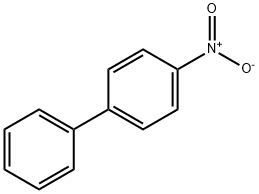
4-НИТРОБИФЕНИЛ
- английское имя4-Nitrobiphenyl
- CAS №92-93-3
- CBNumberCB7482649
- ФормулаC12H9NO2
- мольный вес199.21
- EINECS202-204-7
- номер MDLMFCD00007342
- файл Mol92-93-3.mol
химическое свойство
| Температура плавления | 114 °C |
| Температура кипения | 340 °C |
| плотность | 1.1919 (rough estimate) |
| показатель преломления | 1.5880 (estimate) |
| Fp | 43 °C |
| растворимость | Soluble in acetic acid, benzene, chloroform, and ether (Weast, 1986) |
| форма | Solid |
| цвет | White |
| Растворимость в воде | insoluble |
| Стабильность | Stable. Incompatible with strong oxidizing agents. |
| InChI | InChI=1S/C12H9NO2/c14-13(15)12-8-6-11(7-9-12)10-4-2-1-3-5-10/h1-9H |
| ИнЧИКей | BAJQRLZAPXASRD-UHFFFAOYSA-N |
| SMILES | C1(C2=CC=CC=C2)=CC=C([N+]([O-])=O)C=C1 |
| Непрямые добавки, используемые в веществах, контактирующих с пищевыми продуктами | 4-NITROBIPHENYL |
| Справочник по базе данных CAS | 92-93-3(CAS DataBase Reference) |
| Рейтинг продуктов питания EWG | 4 |
| FDA UNII | QM80NUW6WZ |
| МАИР | 3 (Vol. 4, Sup 7) 1987 |
| Справочник по химии NIST | 1,1'-Biphenyl, 4-nitro-(92-93-3) |
| Предложение 65 Список | 4-Nitrobiphenyl |
| Система регистрации веществ EPA | 4-Nitrobiphenyl (92-93-3) |
больше
| Коды опасности | T,N | |||||||||
| Заявления о рисках | 45-51/53 | |||||||||
| Заявления о безопасности | 53-45-61 | |||||||||
| РИДАДР | 2811 | |||||||||
| RTECS | DV5600000 | |||||||||
| Класс опасности | 6.1(b) | |||||||||
| Группа упаковки | III | |||||||||
| кода HS | 29042090 | |||||||||
| Банк данных об опасных веществах | 92-93-3(Hazardous Substances Data) | |||||||||
| Токсичность | Acute oral LD50 for rats 2,230 mg/kg, rabbits 1,970 mg/kg (quoted, RTECS, 1985). | |||||||||
| NFPA 704: |
|
рисовальное письмо(GHS)
-
рисовальное письмо(GHS)


-
сигнальный язык
опасность
-
вредная бумага
H350:Может вызывать раковые заболевания.
H411:Токсично для водных организмов с долгосрочными последствиями.
-
оператор предупредительных мер
P202:Перед использованием ознакомиться с инструкциями по технике безопасности.
P308+P313:ПРИ подозрении на возможность воздействия обратиться за медицинской помощью.
4-НИТРОБИФЕНИЛ химические свойства, назначение, производство
Химические свойства
4-Nitrobiphenyl exists as yellow plates or needles..Использование
4-Nitrobiphenyl has some uses as a plasticizer, fungicide, and wood preservative.Общее описание
White to yellow needle-like crystalline solid with a sweetish odor.Реакции воздуха и воды
Insoluble in water.Профиль реактивности
4-Nitrobiphenyl is incompatible with the following: Strong reducers .Опасность
Toxic by ingestion and skin contact. Confirmed carcinogen.Угроза здоровью
p-Nitrobiphenyl (PNB) is a urinary bladder carcinogen in dogs.Профиль безопасности
Confirmed carcinogen with experimental carcinogenic, neoplastigenic, and tumorigenic data. Poison by intraperitoneal route. Moderately toxic by ingestion. Mutation data reported. When heated to decomposition it emits toxic fumes of NOx. See also NITRO COMPOUNDS OF AROMATIC HYDROCARBONS.Токсикология
4-Nitrobiphenyl is no longer manufactured or used in the United States. Limited information is available on the health effects of 4-nitrobiphenyl. Acute (short-term) exposure to 4-nitrobiphenyl in humans results in irritation of the eyes, mucous membranes, and respiratory tract, such as headache, nausea, vomiting, and fatigue. Chronic (long-term) exposure to high concentrations of 4-nitrobiphenyl in workers has resulted in effects on the peripheral and central nervous systems as well as the liver and kidney. No information on the reproductive, developmental, or carcinogenic effects of 4-nitrobiphenyl in humans is available. EPA has not classified 4-nitrobiphenyl for carcinogenicity. 4-Nitrobiphenyl is no longer manufactured, imported, used, or sold in the United States.Возможный контакт
4-Nitrobiphenyl was formerly used in the synthesis of 4-aminodiphenyl. It is presently used only for research purposes; there are no commercial uses.Канцерогенность
The case for the carcinogenicity of PNB is supported by (1) the induction of urinary bladder cancer in dogs after administration of PNB; (2) the evidence that PNB is metabolized in vivo to 4-aminobiphenyl (a potent carcinogen); and (3) the possibility that the cases of human urinary bladder cancer attributed to 4- aminobiphenyl may also have been induced by exposure to PNB.1Перевозки
UN2811 Toxic solids, organic, n.o.s., Hazard Class: 6.1; Labels: 6.1-Poisonous materials, Technical Name Required.Несовместимости
Incompatible with strong reducing agents such as hydrides, oxidizers (chlorates, nitrates, peroxides, permanganates, perchlorates, chlorine, bromine, fluorine, etc.); contact may cause fires or explosions. Keep away from alkaline materials, strong bases, strong acids, oxoacids, epoxides.Утилизация отходов
Incineration @ 982℃/2.0 seconds (minimum) with scrubbing for nitrogen oxides abatement.4-НИТРОБИФЕНИЛ запасные части и сырье
4-НИТРОБИФЕНИЛ поставщик
| поставщик | телефон | страна | номенклатура продукции | благоприятные условия | |
|---|---|---|---|---|---|
| +86-023-6139-8061 +86-86-13650506873 |
China | 39894 | 58 | ||
| +86-0371-86658258 +8613203830695 |
China | 29871 | 58 | ||
| 86-13657291602 | CHINA | 22963 | 58 | ||
| 8485655694 | United States | 63687 | 58 | ||
| +8618523575427 | China | 49732 | 58 | ||
| 18017061086 | CHINA | 5600 | 58 | ||
| +86-0551-65418671 +8618949823763 |
China | 34563 | 58 | ||
| +8615250961469 | China | 9720 | 58 | ||
| +86-592-5360779 +86-13055435203 |
China | 5988 | 58 | ||
| +86-89586680 +86-13289823923 |
China | 8670 | 58 |